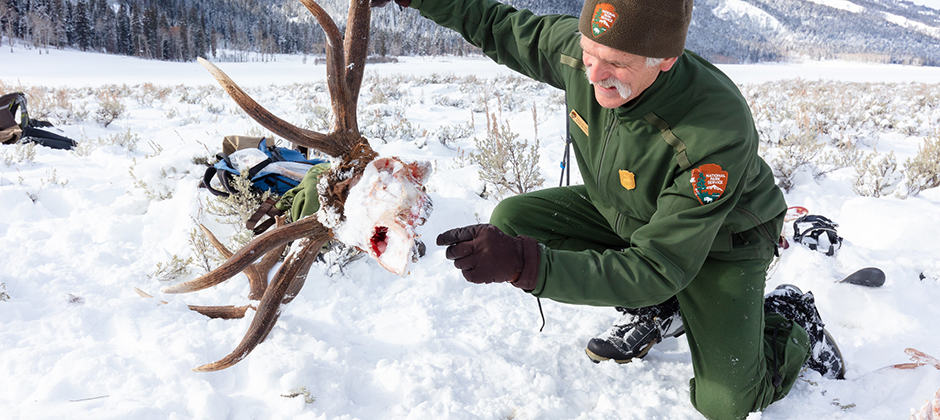Share this article
Climate affects which elk that wolves kill
Douglas Smith and his colleagues had been working on a two-decade-long project tracking gray wolf activity in Yellowstone when he began to notice something strange that seemed counterintuitive to knowledge about predator-prey interactions.
“At the end of the winter, you’d see wolves killing the biggest, baddest male elk,” said Wilmers, a professor of environmental studies at the University of California, Santa Cruz and a colleague of Smith, a senior wildlife biologist with the National Park Service. “It seemed like something was going on — that there was a relationship between the time of year and the climate, and which type of animals they were killing.”
The types of elk (Cervus canadensis) that gray wolves (Canis lupus) kill matters in terms of the cervid populations’ long-term sustainability, Wilmers said. Killing a bull, for example, affects the overall population less than killing a cow. “It’s really your prime age females that are most important in terms of population growth,” Wilmers said.
As he investigated, he discovered that changes in climate — from month to month and year to year — can influence the wolves’ predatory behavior, shifting which elk they prey on. Under some conditions, he found, wolves were taking some of the largest bulls on the landscape. Under others, they were just as likely to pursue females, yearlings or calves. Wilmers and his team published their findings in the Journal of Animal Ecology.
Biologists have been tracking wolf packs in northern Yellowstone for nearly 20 years, documenting many of the kills they make and trying to figure out the age and sex of the prey. Focusing on both early winter and late winter kills, Wilmers’ team found wolf kills varied, but trends emerged that related to the weather in a given winter or during previous seasons.
In late winter, wolves were taking down the biggest bulls more often. It seemed counterintuitive, but Wilmers believes the elk that looked the strongest may not have been the fittest. Male elk typically bulk up as much as possible before fall so that they will have more mating success. “They are interested in getting as big and strong as possible so they can beat up other bulls and hopefully hold a harem of females,” Wilmers said.
The trouble is all this fighting and female chasing takes a lot of time and energy that would otherwise be spent on feeding in preparation for the winter. “They essentially exhaust themselves, so by the end of the winter they have no gas left in the tank,” Wilmers said.
Meanwhile, the females don’t waste energy on these behaviors. “Females are focused on eating all the time,” Wilmers said. But if they don’t have healthy enough reserves of fat by the fall that they’ll need to last the winter, they might just forego having a calf that year.
Wolves were more likely to prey on bulls in the early winter if growing conditions were bad in either of the two preceding summers, leading to weaker bulls. But poor growing conditions also made calves vulnerable to wolf attacks, likely because they didn’t get enough nutrition in utero to develop at the normal rate.
Femur samples biologist took from elk kills added weight to these theories. “The marrow condition in bulls and calves was worse than females,” suggesting they were close to starving and were metabolizing fat in the marrow, Wilmers said.
Late winter kills showed different patterns. Particularly severe winters had an equalizing effect on the types of elk taken by wolves. All prey essentially become weak at that point, and females were taken as much as bulls or calves.
Heavy late winter snow also resulted in a more rapid decline of elk condition in general.
Climate change may have an effect on these predator-prey dynamics as weather becomes more variable. Researchers would have to build a model to include things like snow depth in later winter, growing conditions in previous summers and the overall severity of winter to determine how changing weather might impact the elk population in Yellowstone over time, Wilmers said.
But for now, he said, the findings can better inform hunting quotas outside the park, allowing managers to raise or lower bull tags based on weather conditions.
Header Image: Doug Smith, senior wildlife biologist with the National Park Service, examines the skull of a bull elk killed by a wolf. ©NPS/Jacob W. Frank








